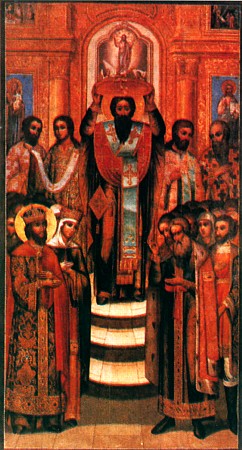
The Commemoration of the Renewal of the Temple of the Resurrection of Christ at Jerusalem
Commemorated on September 13
The Commemoration
of the Renewal of the Temple of the Resurrection of Christ at Jerusalem
celebrates the solemnity on the occasion of the consecration of the Church of
the Resurrection of Christ, built by the Equal-to-the-Apostles Constantine the
Great and his mother Equal-to-the-Apostles the empress Helen. This feastday is
still called among the people by its unique title "having reputation from
the Resurrection" ("Voskresenie slovuschee") and it means that
it reputes to or pertains to the Resurrection, in distinction from the Feast of
the Luminous Resurrection of Christ, and refers particularly to the
consecration of the Church in honour of the Resurrection of Christ.
The history of the
construction of this temple is thus. After the voluntary Passion and Death on
the Cross of our Lord and Saviour Jesus Christ, the holy place of His suffering
was long trampled on by pagans. When the Roman emperor Titus in the year 70
conquered Jerusalem, he razed the city and destroyed the Temple of Solomon on
Mount Moriah, leaving there not a stone upon a stone, as even the Saviour had
foretold about in conversation with the disciples (Mt. 13: 1-2). Later on the
zealous pagan emperor Adrian (117-138) built on the place of the Jerusalem
destroyed by Titus a new city, which was named after his name – Aelia Adriani
(Aelia Capitolina) and made it forbidden to call the city by its former name.
The Holy Sepulchre of the Lord he gave orders to cover over with ground and
stones and on that spot to set up an idol; and on Golgotha where the Saviour
was crucified, in 119 he constructed a pagan-temple dedicated to the goddess
Venus. In front of the statues they offered sacrifice to demons and performed
pagan rites, accompanied by wanton acts. In Bethlehem, at the place the Saviour
was born of the AllPure Virgin, the impious emperor set up an idol of Adonis.
He did all this intentionally, so that people would forget completely about
Christ the Saviour and that they would no more remember the places where He
lived, taught, suffered and arose in glory.

When there began the
reign of Equal-to-the-Apostles Constantine the Great (306‑337), the first
of the Roman emperors to recognise the Christian religion, he together with his
pious mother the empress Helen decided to rebuild the city of Jerusalem and on
the place of the suffering and Resurrection of the Lord to erect a new temple,
to purify from the foul pagan cults the places connected with memory of the
Saviour, and again to consecrate them. The nobleborn empress Helen journeyed to
Jerusalem with a large quantity of gold, and Equal-to-the-Apostles Constantine
the Great wrote a letter to Patriarch Makarios I (313-335), in which he
requested him to assist in every possible way for the task of the renewal of
the Christian holy places. Having arrived in Jerusalem, the holy empress Helen
destroyed all the idolous pagan temples and had the desecrated places
re-consecrated. She was ardent with the desire to find the Cross of our Lord
Jesus Christ and she gave orders to dig up the place, where stood the temple of
Venus. There they discovered the covered over Sepulchre of the Lord and the
place of the Skull, not far from where they found three crosses and nails. In
order to determine, upon which of the three crosses lay the Saviour, Patriarch
Makarios gave orders to touch alternately against a dead person, whom they
happened to be carrying by towards a place of burial. Just as the Cross of
Christ touched the dead person, he immediately came alive. With the greatest of
joy the nobleborn empress Helen and Patriarch Makarios raised up high the
Life-Creating Cross and displayed it to all the people standing about.
The holy empress
quickly set about the construction of a large church, which enclosed in its
walls the place of the Crucifixion of the Saviour – Golgotha, and the
Sepulchre of the Lord, located a not large distance from each other, and as the
holy Apostle and Evangelist John wrote about this: "At that place, where
He was crucified, was a garden and in the garden a new tomb, in which still no
one had been put; there they did place Jesus because of the Jewish Friday,
since that the tomb was nearby" (Jn. 19: 41-42). The Church of the
Resurrection was 10 years in building, and the holy empress Helen did not
survive to the completion of construction. Having returned to Constantinople,
she reposed in the year 327. After the time of her arrival in Jerusalem the
holy empress built churches in Bethlehem, on the Mount of Olives, at Gethsemane
and in many other places, connected with the life of the Saviour and events in
the New Testament.
The completion of
construction of the New Testament temple of the Resurrection of Christ, called
"Martyrion", in memory of the sufferings of the Cross of the Saviour,
co‑incided with the passage of the First Council of Tyre, and with it the
thirty year reign of the Equal-to-the-Apostles Constantine the Great. Wherefore
at the assemblage of 13 September 335 the consecration of the temple was
particularly solemn. At the consecration of the church participated hierarchy
of the Christian Churches from many lands: Bythnia, Thrace, Cilicia,
Cappadocia, Syria, Mesopotamia, Phoenicia, Arabia, Palestine and Egypt. To the
solemnity of the renewal were invited only the fathers that concluded the Tyre
Council. On this day was consecrated all the city of Jerusalem. The
commemoration of this remarkable event by the fathers of the Church was
established as 13 September.
© 1996-2001 by translator Fr. S. Janos.